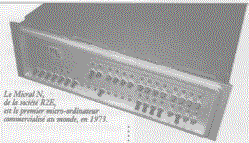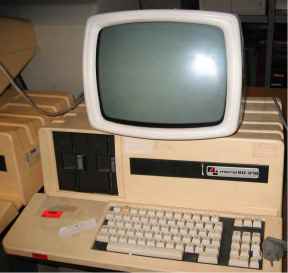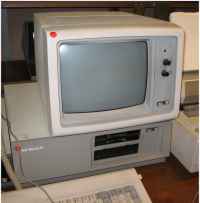
Bull
microcomputers
a summary
by Jean Bellec for FEB
Although Bull technologists and architects were well aware in the 1970s of the advances in integrated circuits technology, they underestimate the impact of the standardization of VLSI on the industry. They were still consider those circuits either as the extrapolation of the MSI building blocks or as engineering models of a "silicon compilation" technology that will become soon available to all designers.
Even small computers architects and terminals designers essentially neglect the introduction of Intel microprocessors as being marginal for the main stream of the business. The first integrated processor was Intel 4004 developed for the calculator market. Its approach did not seem to give it to compete in the general purpose market. Other approaches, like the bit slice VLSI seemed preferable to architects. The 8008 also did not retain much attention.
On the contrary, for a few engineers at
Intertechnique working on proprietary minicomputers, the 8008 appeared as a revolutionary
device. They were unable to convince their management and founded a "garage
company" that will be known as R²E ( or REE ).
The R²E lab was not really built in a garage, but in the basement of a small house
at Chatenay-Malabry a southern suburb of Paris. The chief designer was François Gernelle
and the manager was André Truong Than Thy. Although, R²E is credited to
have developed the first personal computer in the world in 1973, the fact is that it
developed the first general purpose computer powered by a microprocessor.
The Micral N was initially installed as a mobile process control
computer for the Institut de Recherches Agronomiques. R²E was able to secure an important
contract for equipping the toll gates of French autoroutes where Micral remain in
service until 1992.
<
REE was eventually acquired by CII-Honeywell Bull in 1978 and operated as an independent subsidiary company as Bull-Micral. François Gernelle left the company and André Truong retained for some time in charge of the Bull division. Bull-Micral software division developed a multi-terminal operating system named Prologue that was essentially targeting business applications. A data base system called Dialogue and a macro-assembler application language BAL completed the Prologue system.
A line of computers based on Intel 8080 and 8086 was developed.

When IBM entered the PC market, in 1981, some Micral engineers advocate to stay within the growing Prologue market and to stay apart from the PC clones. Other, located in Minneapolis within R2E of America, founded by André Truong, were sensible to the emerging open systems and developed a clone prototype based on IBM PC market. In France, Bull-Micral engineers were facing an internal competition from Transac, a company recently acquired from CGE, and from ex-Thomson subsidiary that brought the license of Convergent Technology hardware and CTOS software, targeting the same business market as Prologue and that were given the Bull's blessing as the main stream product (marketed as Questar 400).
Finally, Bull's management stated that Bull-Micral would be focusing on the IBM clone market and introduced in 1984 the BM-30 (developed at R2E of America) as the Bull's PC. The Prologue operating system was converted to the PC architecture and the Micral 30 was marketed by Bull either with Prologue or more frequently with MS-DOS.

When IBM switched to the 80286 in 1984, Bull-Micral followed with the Micral BM-60. The manufacturing of the PC was made at the brand new plant of Villeneuve d'Asq. During that period, Bull was betting on its ability to produce its Bull designed disk drives for the PC. But that effort was unfruitful.
The introduction of the Compaq 386 took Bull-Micral somewhat unprepared and lead to the first OEM import of a Multitech (now Acer from Taiwan) sold as Micral BM-600, a robust reliable but expensive machine.
Bull-Micral had been integrated with Bull-Transac in 1983 and the majority of early engineers had quitted. They were replaced by engineers having developed terminals in CII and CII-HB that developed between 1985 and 1988, several desk-top systems based on 286 and 386, including a PS/2 clone with MCA system bus. That offer was completed by imports of lap-top computers from S-E Asia.
The Prologue business limited to a niche market was gave away to a management buy-out of the Prologue division that became progressively independent under Georges Seban. It succeeded to sell licenses to Microsoft for the MTS subsystem of Windows/NT and progressively ported its software to that environment.
None of those product encountered a big success, essentially because Bull traditional sales network was unable to convert into a PC distribution network, and that it devoted its energy on most profitable markets to sell the Questar 400. Bull decided in 1988 to spend its capital influx from the French government in acquiring an American PC company that could be more proactive and had the experience of PC distribution. Zenith was then trying to sell its PC division that was eventually acquired by Bull as Zenith Data Systems.
Zenith had secured important contracts from the US Department
of Defense, profiting on the ban on Toshiba products, for laptops manufacturing and had a
sizeable sales worldwide network. The take-over by Bull menaced the DoD contracts, but
they were finally fulfilled, Zenith kept its operational independence within Bull , but
the kernel of designers having built the company left after no more than two years and
Zenith enters the 1990s with evaporating assets. Bull attempted to reshuffle the
management of ZDS (under Enrico Pesatori then Jacques Noels) but remained unable to
compete successively with Compaq or with new entrants like Dell and Gateway.
An opportunity appeared in 1992, when the agreement between Bull and IBM (on
PowerPC) opened to ZDS the door for becoming a laptop supplier of IBM. Product
deficiencies and political turmoil at Bull closed that opportunity.
A consolidation of ZDS desktop computers with those of Packard-Bell
was made in 1993, but the specialization of Packard-Bell towards the low-end
family market unfitted the Bull's business base.
However, the Packard-Bell agreement allowed Bull to resolve, with the help of Angers
municipality, a part of its excess manufacturing capacity in Angers, by transferring
a significant part of the plant area to Packard-Bell.
The laptop activity became limited to a work of specifications for Taiwanese or Korean OEM suppliers. ZDS became rapidly unable to fulfill the high-end, reputed more profitable, PC market. In 1995, solicited by NEC that had a limited success in its NEC of America operation and by Packard-Bell, a private company, that became unable to hide its losses, Bull decided to consolidate all its microcomputers activities under NEC umbrella as NEC-Packard-Bell and to exit from the PC market as a manufacturer.
While NEC-Packard-Bell has suspended its activities in North America, it keeps its manufacturing plants in Europe in UK and in Angers.
Revision : 28 mars 2002.